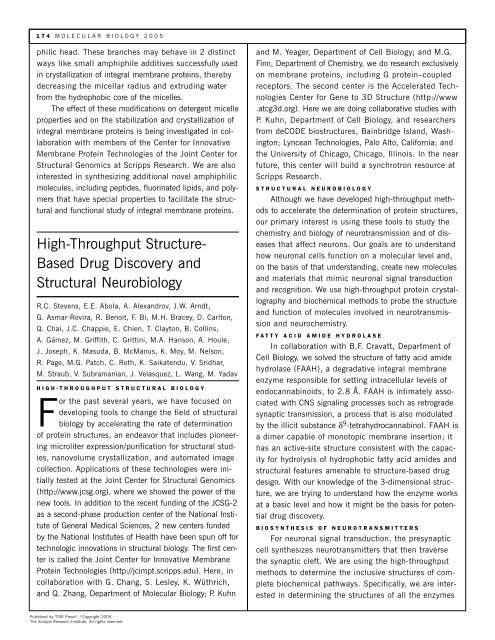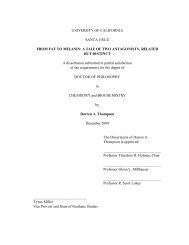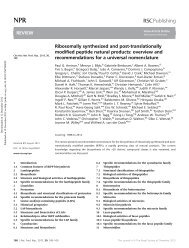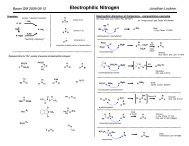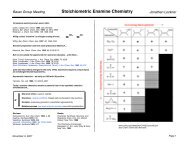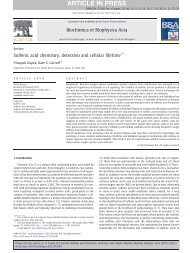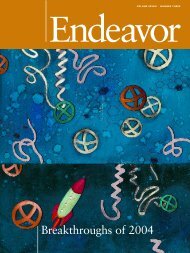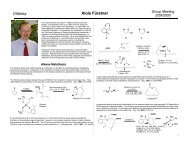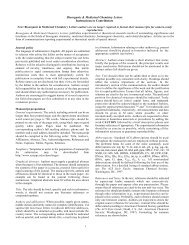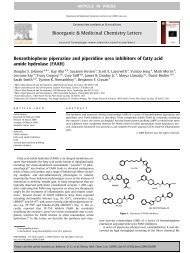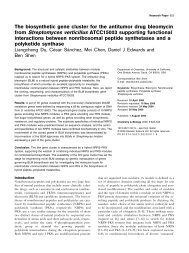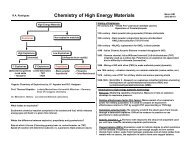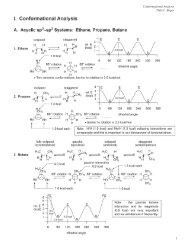Molecular Biology - The Scripps Research Institute
Molecular Biology - The Scripps Research Institute
Molecular Biology - The Scripps Research Institute
Create successful ePaper yourself
Turn your PDF publications into a flip-book with our unique Google optimized e-Paper software.
174 MOLECULAR BIOLOGY 2005<br />
philic head. <strong>The</strong>se branches may behave in 2 distinct<br />
ways like small amphiphile additives successfully used<br />
in crystallization of integral membrane proteins, thereby<br />
decreasing the micellar radius and extruding water<br />
from the hydrophobic core of the micelles.<br />
<strong>The</strong> effect of these modifications on detergent micelle<br />
properties and on the stabilization and crystallization of<br />
integral membrane proteins is being investigated in collaboration<br />
with members of the Center for Innovative<br />
Membrane Protein Technologies of the Joint Center for<br />
Structural Genomics at <strong>Scripps</strong> <strong>Research</strong>. We are also<br />
interested in synthesizing additional novel amphiphilic<br />
molecules, including peptides, fluorinated lipids, and polymers<br />
that have special properties to facilitate the structural<br />
and functional study of integral membrane proteins.<br />
High-Throughput Structure-<br />
Based Drug Discovery and<br />
Structural Neurobiology<br />
R.C. Stevens, E.E. Abola, A. Alexandrov, J.W. Arndt,<br />
G. Asmar-Rovira, R. Benoit, F. Bi, M.H. Bracey, D. Carlton,<br />
Q. Chai, J.C. Chappie, E. Chien, T. Clayton, B. Collins,<br />
A. Gámez, M. Griffith, C. Grittini, M.A. Hanson, A. Houle,<br />
J. Joseph, K. Masuda, B. McManus, K. Moy, M. Nelson,<br />
R. Page, M.G. Patch, C. Roth, K. Saikatendu, V. Sridhar,<br />
M. Straub, V. Subramanian, J. Velasquez, L. Wang, M. Yadav<br />
HIGH-THROUGHPUT STRUCTURAL BIOLOGY<br />
For the past several years, we have focused on<br />
developing tools to change the field of structural<br />
biology by accelerating the rate of determination<br />
of protein structures, an endeavor that includes pioneering<br />
microliter expression/purification for structural studies,<br />
nanovolume crystallization, and automated image<br />
collection. Applications of these technologies were initially<br />
tested at the Joint Center for Structural Genomics<br />
(http://www.jcsg.org), where we showed the power of the<br />
new tools. In addition to the recent funding of the JCSG-2<br />
as a second-phase production center of the National <strong>Institute</strong><br />
of General Medical Sciences, 2 new centers funded<br />
by the National <strong>Institute</strong>s of Health have been spun off for<br />
technologic innovations in structural biology. <strong>The</strong> first center<br />
is called the Joint Center for Innovative Membrane<br />
Protein Technologies (http://jcimpt.scripps.edu). Here, in<br />
collaboration with G. Chang, S. Lesley, K. Wüthrich,<br />
and Q. Zhang, Department of <strong>Molecular</strong> <strong>Biology</strong>; P. Kuhn<br />
Published by TSRI Press ®. ©Copyright 2005,<br />
<strong>The</strong> <strong>Scripps</strong> <strong>Research</strong> <strong>Institute</strong>. All rights reserved.<br />
and M. Yeager, Department of Cell <strong>Biology</strong>; and M.G.<br />
Finn, Department of Chemistry, we do research exclusively<br />
on membrane proteins, including G protein–coupled<br />
receptors. <strong>The</strong> second center is the Accelerated Technologies<br />
Center for Gene to 3D Structure (http://www<br />
.atcg3d.org). Here we are doing collaborative studies with<br />
P. Kuhn, Department of Cell <strong>Biology</strong>, and researchers<br />
from deCODE biostructures, Bainbridge Island, Washington;<br />
Lyncean Technologies, Palo Alto, California; and<br />
the University of Chicago, Chicago, Illinois. In the near<br />
future, this center will build a synchrotron resource at<br />
<strong>Scripps</strong> <strong>Research</strong>.<br />
STRUCTURAL NEUROBIOLOGY<br />
Although we have developed high-throughput methods<br />
to accelerate the determination of protein structures,<br />
our primary interest is using these tools to study the<br />
chemistry and biology of neurotransmission and of diseases<br />
that affect neurons. Our goals are to understand<br />
how neuronal cells function on a molecular level and,<br />
on the basis of that understanding, create new molecules<br />
and materials that mimic neuronal signal transduction<br />
and recognition. We use high-throughput protein crystallography<br />
and biochemical methods to probe the structure<br />
and function of molecules involved in neurotransmission<br />
and neurochemistry.<br />
F A TTY ACID AMIDE HYDROLASE<br />
In collaboration with B.F. Cravatt, Department of<br />
Cell <strong>Biology</strong>, we solved the structure of fatty acid amide<br />
hydrolase (FAAH), a degradative integral membrane<br />
enzyme responsible for setting intracellular levels of<br />
endocannabinoids, to 2.8 Å. FAAH is intimately associated<br />
with CNS signaling processes such as retrograde<br />
synaptic transmission, a process that is also modulated<br />
by the illicit substance δ 9 -tetrahydrocannabinol. FAAH is<br />
a dimer capable of monotopic membrane insertion; it<br />
has an active-site structure consistent with the capacity<br />
for hydrolysis of hydrophobic fatty acid amides and<br />
structural features amenable to structure-based drug<br />
design. With our knowledge of the 3-dimensional structure,<br />
we are trying to understand how the enzyme works<br />
at a basic level and how it might be the basis for potential<br />
drug discovery.<br />
BIOSYNTHESIS OF NEUROTRANSMITTERS<br />
For neuronal signal transduction, the presynaptic<br />
cell synthesizes neurotransmitters that then traverse<br />
the synaptic cleft. We are using the high-throughput<br />
methods to determine the inclusive structures of complete<br />
biochemical pathways. Specifically, we are interested<br />
in determining the structures of all the enzymes


